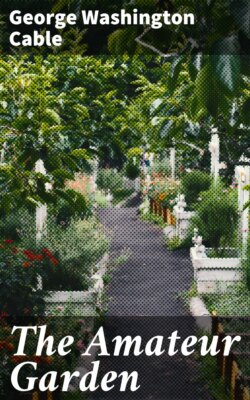Читать книгу The Amateur Garden - George Washington Cable - Страница 6
На сайте Литреса книга снята с продажи.
"On this green of the dryads … lies My Own Acre." The two young oaks in the picture are part of the row which gives the street its name.
Оглавление"Contour paths" was the word he gave me; paths starting from the top of the steep broken ground and bending in and out across and around its ridges and ravines at a uniform decline of, say, six inches to every ten feet, until the desired terminus is reached below; much as, in its larger way, a railway or aqueduct might, or as cattle do when they roam in the hills. Thus, by the slightest possible interference with natural conditions, these paths were given a winding course every step of which was pleasing because justified by the necessities of the case, traversing the main inequalities of the ground with the ease of level land yet without diminishing its superior variety and charm. And so with contour paths I began to find, right at my back door and on my own acre, in nerve-tired hours, an outdoor relaxation which I could begin, leave off and resume at any moment and which has never staled on me. For this was the genesis of all I have learned or done in gardening, such as it is.
My appliances for laying out the grades were simple enough: a spirit-level, a stiff ten-foot rod with an eighteen-inch leg nailed firmly on one end of it, a twelve-inch leg on the other, a hatchet, and a basket of short stakes with which to mark the points, ten feet apart, where the longer leg, in front on all down grades, rested when the spirit-level, strapped on the rod, showed the rod to be exactly horizontal. Trivial inequalities of surface were arbitrarily cut down or built up and covered with leaves and pine-straw to disguise the fact, and whenever a tree or anything worth preserving stood in the way here came the loaded barrow and the barrowist, like a piece of artillery sweeping into action, and a fill undistinguishable from nature soon brought the path around the obstacle on what had been its lower side, to meander on at its unvarying rate of rise or fall as though nothing—except the trees and wild flowers—had happened since the vast freshets of the post-glacial period built the landscape. I made the drive first, of steeper grade than the paths; but every new length of way built, whether walk or road, made the next easier to build, by making easier going for the artillery, the construction train. Also each new path has made it easier to bring up, for the lawn garden, sand, clay, or leaf-mould, or for hearth consumption all the wood which the grove's natural mortality each year requires to be disposed of. There is a superior spiritual quality in the warmth of a fire of h-oak, h-ash, and even h-ellum gathered from your own acre, especially if the acre is very small and has contour paths. By a fire of my own acre's "dead and down" I write these lines. I never buy cordwood.
Only half the grove has required these paths, the other half being down on the flat margin of the river, traversed by a cart-road at least half a century old, though used by wheels hardly twice a year; but in the three acres where lie the contour paths there is now three-fifths of a mile of them, not a rod of which is superfluous. And then I have two examples of another kind of path: paths with steps; paths which for good and lawful reasons cannot allow you time to go around on the "five per cent" grade but must cut across, taking a single ravine lengthwise, to visit its three fish-pools.
These steps, and two short retaining walls elsewhere in the grove, are made of the field stones of the region, uncut. All are laid "dry" like the ordinary stone fences of New England farms, and the walls are built with a smart inward batter so that the winter frosts may heave them year after year, heave and leave but not tumble them down. I got that idea from a book. Everything worth while on my acre is from books except what two or three professional friends have from time to time dropped into my hungry ear. Both my ears have good appetites—for garden lore.
About half a mile from me, down Mill River, stands the factory of a prized friend who more than any other man helps by personal daily care to promote Northampton's "People's Institute," of whose home-garden work I have much to say in the chapters that follow this one. For forty years or more this factory has been known far and wide as the "Hoe Shop" because it makes shovels. It has never made hoes. It uses water-power, and the beautiful mill-pond behind its high dam keeps the river full back to the rapids just above my own acre. In winter this is the favorite skating-pond of the town and of Smith College. In the greener seasons of college terms the girls constantly pass upstream and down in their pretty rowboats and canoes, making a charming effect as seen from my lawn's rear edge at the head of the pine and oak shaded ravine whose fish-pools are gay by turns with elder, wild sunflower, sumach, iris, water-lilies, and forget-me-not.
